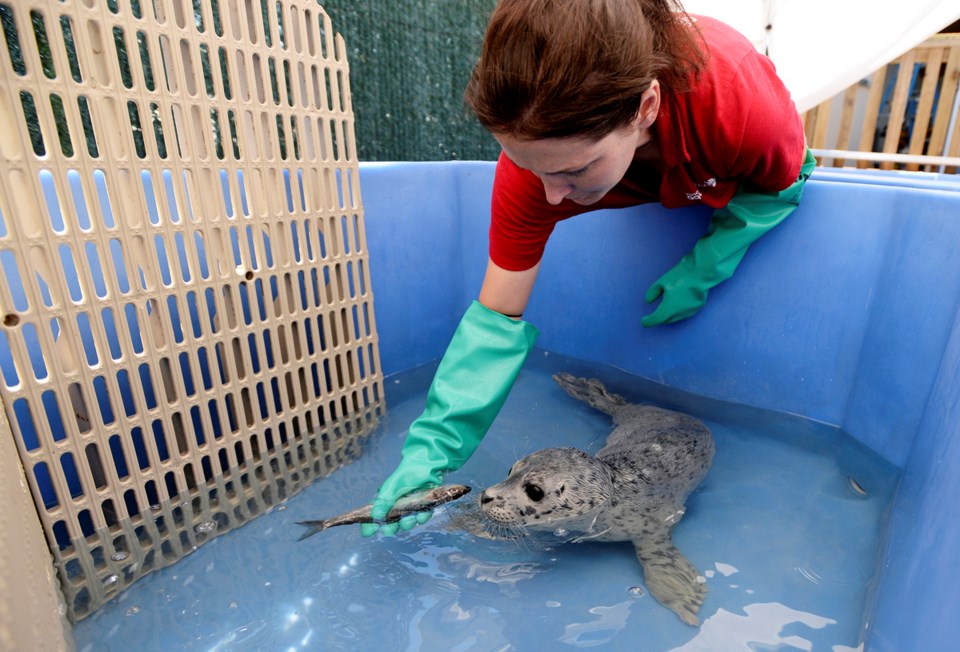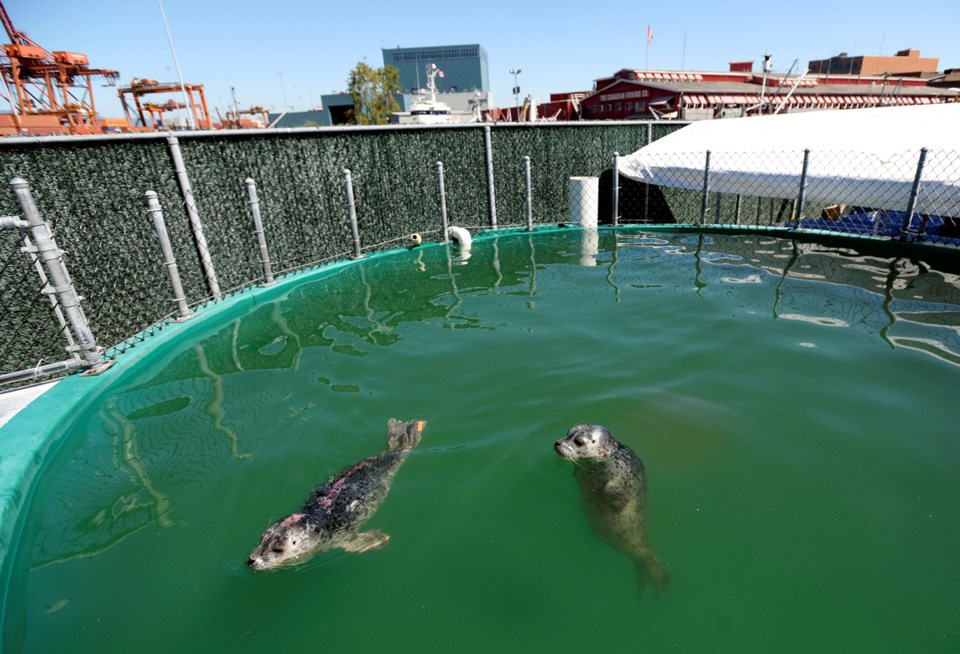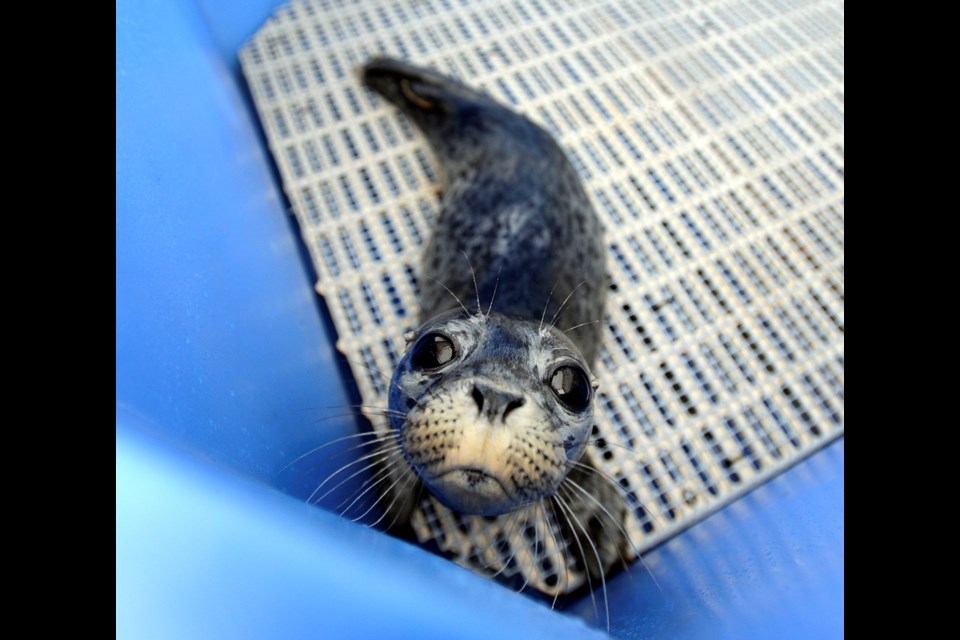Separated from his mother soon after birth, Sealy McSealface spends his nascent days in the company of human caretakers and moony-eyed critters like himself.
Sealy is one of 112 harbour seal pups in rehab at Vancouver Aquarium’s Marine Mammal Rescue Centre. Weeks of rehabilitation following his rescue from Wreck Beach last month have prepped him for his fast-approaching release back into the wild.
With pupping season at its peak, harbour seals in B.C. are crawling ashore by the thousands to give birth. Pups stranded as a result of maternal separation or injuries are taken to the rescue centre where staff and volunteers are working tirelessly — feeding pups, cleaning pools, administering medication and tending to wounds.
It is an innate human urge, research tells us, to assist a young animal in distress — an instinct harbour seals like Sealy benefit from. But some in the marine science field are questioning whether this impulse warrants a painstaking rescue program that could disturb nature’s balancing act.
Unlike most animals entitled to exhaustive rescue efforts, harbour seals are not endangered — far from it.
With an estimated population of 40,000 in the Strait of Georgia and 105,000 off the B.C. coast, harbour seals are at carrying capacity, which is the maximum population size of a species the ecosystem can sustain indefinitely.
From 1879 to 1914 and 1962 to 1968, harbour seals in B.C. were hunted for pelts, according to a population assessment report by Fisheries and Oceans Canada.
They were also culled to reduce competition for commercially valuable fish stocks. Over-hunting during these
periods threatened their numbers, but the population grew dramatically after the species received federal protection in 1970.
Acts of compassion
At this time of year, harbour seal pups are commonly found alone on beaches. Strandings are reported by shoreline residents and visitors. Unable to turn a deaf ear to a pup’s cries — eerily akin to a child’s — callers urge rescue staff to assist the pup.

But not all beached pups are abandoned says Lindsaye Akhurst, manager at the Marine Mammal Rescue Centre. Mothers will leave newborn pups to rest and stay warm for hours or even days while they hunt for food.
Callers are instructed to observe the pup from a distance and look for signs of injury, dehydration or starvation. If the pup seems healthy, rescuers wait eight to 12 hours before picking it up to determine if the seal is indeed stranded.
Akhurst said every so often “well-meaning people” disregard directions and load pups into crates or car trunks, after which rescuers have no option but to bring them into rehab.
“If you’ve seen harbour seals, you know how cute they are with their big brown eyes looking at you. Your heart goes out to them,” she said. “So there are people who think they’re doing the right thing and unfortunately it may not be the right thing.”
Rehabilitation costs
More than 25,000 hours and $500,000 devoted every year to the Marine Mammal Rescue Centre suggests the Vancouver Aquarium is deeply invested in the rehabilitation of pinnipeds and other marine mammals.
According to Akhurst, 150 harbour seal pups rescued each year make up more than 95 per cent of patients rehabilitated at the rescue centre. It can cost anywhere between $1,500 and $3,000 to rehabilitate a single seal pup.
The aquarium’s highly publicized rescue program pulls in donations and grants which bankroll the rescue centre, in addition to funds generated through aquarium operations. The aquarium also has a seal adoption program that allows people to symbolically adopt rescued harbour seal pups.
At the rescue centre — the location of which is undisclosed to the public — every new arrival is kept under quarantine for a minimum of two weeks and screened for bacterial, viral or parasitic infections. Pups are fed, cleaned and provided veterinary care as they undergo three stages of rehabilitation. After making a full recovery, which usually takes two to three months, they are released back into the ocean.
“It’s the humane thing to do,” is the aquarium’s justification for rescuing a species of lowest conservation need, but the program is also a response to vigorous public demand, Akhurst said.
“We’re able to bring the pups into our centre and put people’s minds at ease — that somebody’s out there doing something about these little guys,” she said.

Hands-off approach
South of the border, however, seal strandings are dealt with in a different manner.
Harbour seals are swarming the San Juan Islands in Washington state, but stranded pups are condemned to die unless rescued — a reality authorities believe is nature at work.
Jennifer Olson, stranding coordinator at the San Juan County Marine Mammal Stranding Network, told the Courier her team does not intervene in cases of natural mortality, which often means leaving seal pups on the beach.
“Harbour seals in this area are considered to be at carrying capacity and that is largely what drives this ‘hands-off’ policy,” she said.
There are some instances, Olson said, where they would step in to collect a seal pup for rehabilitation and those are cases of negative human interaction. A seal pup that displays evidence of an entanglement or fisheries interaction, for instance, would be a considered a suitable candidate for rescue.
The stranding network’s field response efforts are focused on mitigating harassment and trying to maximize a pup’s chances to survive in the wild.
This involves public education and occasionally even “babysitting” a seal pup on a beach to keep people and dogs away. If a pup is stranded in a hazardous location, the network considers relocating them to a nearby haul-out site.
“It is not always popular — harbour seal pups are adorable and it is easy to get emotionally invested in them. But the high natural mortality rate helps keep the seal population at a sustainable level,” Olson said.
The San Juan County Marine Mammal Stranding Network adheres to the National Oceanic and Atmospheric Administration’s non-interference policy when dealing with seal strandings.
Michael Milstein, public affairs officer at NOAA Fisheries, explained the policy is based on studies that suggest seal pups have the best chance of surviving if they remain in the wild and with their mothers.
“Studies have shown that pups removed from their mothers and ‘rescued’ are not as effective at foraging as those that stay with their mothers and learn to pursue prey that way,” Milstein said.
Balancing act
A 2012 report by the UK/Ireland-based Seal Conservation Society suggests increasing the juvenile harbour seal population every year may interfere with the populations’ natural self-regulation mechanism. The report states this could result in “poorer survival of the next cohort of pups.”
Pollution and reduction of food stocks are new threats to the harbour seal population. The Vancouver Aquarium insists its rescue program “helps to keep this [harbour seal] population stable,” even though releasing more harbour seals into the ocean might be putting greater pressure on dwindling fish stocks.
But some researchers say the biological implications of adding 100 harbour seals to a bountiful population of 40,000 are not very significant.
“By contributing 100 or so animals into that sizable population it’s really not significant in terms of any concerns of weakening the gene pool by saving animals that would otherwise be failing to compete with the wild population,” said John K. Ford, head of the cetacean research program at Fisheries and Oceans Canada and a former research scientist at the Vancouver Aquarium.
Ford added that the harbour seal population is not going unchecked. Mammal-hunting, transient killer whales, which had abandoned the Strait of Georgia by the late 1960s, have returned and could keep the seal population under control.
With B.C. salmon stocks at record lows and harbour seal populations at record highs, researchers are investigating the impact of seal predation with a newfound vigour.
According to a 2015 study by Ben Nelson, a PhD student and research assistant at the University of British Columbia, harbour seals may be impeding the recovery of juvenile chinook and coho salmon in the Strait of Georgia.
Researchers found survival rates of chinook and coho — historically, two of the most commercially valuable salmon species in western North America — declined dramatically after the harbour seal population exploded in the 1970s.
Although there’s no empirical evidence of rescue programs affecting the numbers of juvenile salmon, Nelson said releasing more seals into Strait of Georgia could unfavourably impact salmon restoration efforts.
“One could make the argument based on what we’ve found about seal diets recently — the fact that they do eat significant numbers of juvenile salmon — that those rehab efforts may be at odds with salmon conservation,” Nelson said.
‘Every animal counts’
The aquarium’s Marine Mammal Rescue Centre is the only facility of its kind in Canada, and the efforts of the veterinarians, rehabilitation specialists and volunteers who care for ill and injured marine mammals are significant. Nursing harbour seal pups back to health is a laborious endeavour the rescue centre has zealously undertaken.
Rehabilitating animals allows researchers to monitor disease, toxicity levels and the impact of human activity on these populations, particularly those at risk due to habitat destruction and environmental damage.
Mounted on the walls of the rescue centre are framed photographs of rescued harbour seals, porpoises and sea lions, with a slogan: “Every animal counts.”
That may be so, but considering the amount of time, money and media attention showered on a fresh batch of dewy-eyed harbour seal pups, it would appear some count more than others.



